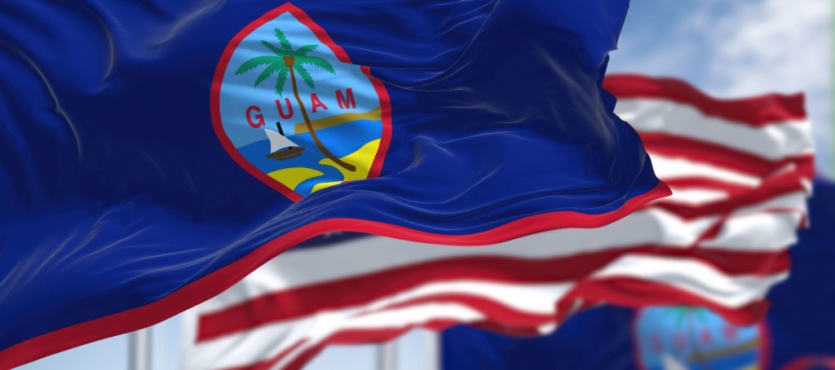The first of thousands of Marines currently stationed on Okinawa Island may take up residence in their new digs in Guam as early as June 2025, according to a base spokesperson.
Maj. Diann Rosenfeld said that “current planning efforts support the commander’s priority to begin moving Marines and Sailors into the barracks aboard the Main Cantonment,” she wrote. “The barracks are designed to support the ranks of sergeant and below.” The base has eight enlisted barracks under construction with a capacity for about 600 troops each, for a total of around 4,800 Marines, she added.
Blaz, the first new Marine Corps installation in 72 years, is still largely under construction, but the base has completed numerous projects as it prepares for an influx of Marines from Okinawa. Japan is providing approximately $3 billion of the estimated $8.6 billion construction costs for Blaz and other infrastructure.
Completed projects on Guam include numerous infrastructure upgrades, an aviation maintenance hangar, a waterfront headquarters building at Naval Base Guam, family housing units at Andersen, a fire station, and an administration building.
Why are Marines Leaving Okinawa?
Eighty years after World War II ended, some 50,000 American servicemembers remain in Japan. More than half of them are in Okinawa. The sprawling military bases on this tiny island take up almost a fifth of the island’s land area. Rather understandably, many Japanese people are not too happy that such a large foreign military force is permanently entrenched on their soil. Moreover, this controversy runs deeper than that.
In 1952, the occupying American forces withdrew from most of the Amami Islands (Ryukyu Islands), which include Okinawa. But the American occupation of Okinawa continued for almost another twenty years. Even after the Americans ended military occupation, nothing much changed on the island, as most troops remained.
Those troops are a thorn in the side of many Japanese. They resent a foreign army, and they are a painful reminder of events that transpired in the first half of the twentieth century. Making matters worse, the Americans have not been very good houseguests.
Controversy began in 1955, when an American sailor allegedly raped a 6-year-old girl. Some 200,000 Okinawans rose up in protest across the island. A similar incident in 1965 sparked a similar response. Those protestors were also upset over Okinawa’s role as a Vietnam War staging area.
The situation has not improved. In April 2025, police began investigating a Marine who allegedly raped one Japanese woman and seriously injured another one. Okinawa Gov. Denny Tamaki called the latest cases “deplorable” and said authorities would urge the U.S. military to prevent similar incidents, Japanese media reported.
Japan’s top government spokesman, Yoshimasa Hayashi, declined to comment on the cases at a regular briefing Thursday, but said crimes by U.S. troops were “unacceptable.”
These crimes bring up echos of perhaps the worst such incident in this saga, the 1995 gang rape of a 12-year-old girl by three U.S. soldiers. That crime almost prompted officials to reconsider the 1960 security treaty that allows Americans to remain on Okinawa.
Why are Marines Coming to Guam?
The controversy in Japan allows U.S. officials to kill two birds with one stone. In addition to downsizing operations on Okinawa, they have a chance to upgrade the military presence on Guam. Much like Okinawa was a staging area in Vietnam, Guam may be a staging area if the war against China comes.
Guam’s location makes it an ideal staging area. It is close enough to China to launch missile attacks and aircraft sorties. But unlike Okinawa, Guam is far enough away to give base officials plenty of warning if any attack comes.
The new arrivals bolster an ongoing buildup. Several large bomber groups have relocated to Guam in recent years. The DoD has also stepped up military exercises with Australia and other military allies in the region, as a possible show of force.
Politically, the buildup on Guam is acceptable to locals. They may not like it, but they accept it. Guam has been a U.S. possession since the end of the Spanish-American War. Before then, Guam was a Spanish colony for some four hundred years. So, Guamans have reluctantly accepted the fact that their island will forever be subject to foreign domination.
Private Military Contractor Duties
Contractors built the fancy new Camp Blaz barracks. These barracks look like luxury apartments, not army barracks. Contractors have been busy on other construction projects on Guam as well. As the buildup continues, their workload increases.
We mentioned the transfer of several new bomber groups. Modern long-range bombers need large hangars and long runways. Many of Guam’s facilities date back to the Cold War. So, contractors must upgrade them, and they must upgrade them quickly.
The systems themselves also need lots of maintenance. Contractors are ideally suited for this maintenance. Many contractors worked at the companies that designed and built these systems. So, only contractors know how to maintain them in battle-ready condition.
Contractors also provide security at these facilities. Many contractors are former law enforcement officers, so they are accustomed to guard duty that regular servicemembers consider a form of punishment.
Injury Compensation Available
Construction accidents, like falls and electrocutions, often cause serious injuries. A Defense Base Act lawyer forces insurance companies to pay these bills, which include:
- Transportation Expenses: The medical facilities on Guam are little more than first-aid stations. Doctors on Guam can stabilize serious injury victims, but that’s about it. These victims must then be transported via air to large hospitals elsewhere. These flights often cost tens of thousands of dollars.
- Emergency Treatment: Because of the treatment delay, serious injuries usually become catastrophic (life-threatening) injuries. These victims usually require extensive medical intervention. Usually, doctors must perform surgery a little bit at a time, because the victims are so physically weak. The upgraded intervention and piecemeal approach drive up medical bills.
- Physical Therapy: More extensive treatment on the front end usually means more extensive physical therapy on the back end. The more extensive treatment also changes the physical therapy pattern. Instead of steady increases, progress comes in fits and starts. Insurance companies often try to pull the financial plug when progress seemingly plateaus. A Defense Base Act lawyer helps ensure that the money keeps flowing and victims continue improving.
Medical benefits are also available to occupational disease victims, such as toxic exposure cancer victims.
In each instance, the insurance company must pay all reasonably necessary medical bills. This requirement is often difficult to establish in court. Fortunately, injured contractors can see their own doctors, at least in most cases. Independent doctors are much more likely to provide reasonably necessary treatment than company doctors.
For more information about other DBA benefits, such as lost wage replacement, contact Barnett, Lerner, Karsen, Frankel & Castro, P.A.

